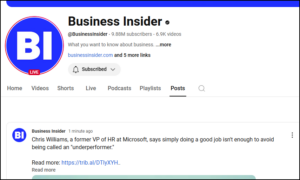If you want to improve the Google rankings for your key pages, the ideal content combination is text, photos/images, a call-to-action and a video.
Videos are important because you and I might be quite happy to read huge pages of text, but a lot of people prefer to absorb that content via a short video instead (yes, yes, I’m aware of the irony of not having a video on this article).
Best practice is to embed your videos into your webpages and serve them from YouTube of Vimeo. YouTube has the advantage of being free, but there is a slight disadvantage that the viewers will see a list of recommended videos to watch next that may be completely unrelated to your brand.
Here is a list of 12 ways to optimise your YouTube videos to give them the best chance of appearing in Google search results and also in YouTube search.
- Start with the target keyword(s)
- Take a moment to think of a few keywords or short phrases you want to rank well for with this video
- Include this keyword or phrase in the video title, description, and as a tag.
- Create a Thumbnail
- Create a template for your video thumbnails that includes the title of the video
- Craft a Title
- Think of the title as a headline in an article. Interesting headlines get read, interesting video titles get watched
- Don’t make them short, use several information bearing keywords. Ask a question, make a statement, make it interesting
- Choose a Category
- Take a moment to carefully choose the appropriate category
- Less popular categories have less competition
- Eg Instead of the popular “Science & Technology” category, consider “events” , “how to”, “education” , etc if the video fits under those
- Write a Description
- Make full use of the description field
- Start the description box with the full url of the article to make the link clickable
- You can also have multiple hyperlinks in the articles, just be sure to use the full url not just www…
- Search engines are starting to watch videos, but they still lean heavily on the description text to get a feel for what the video’s topic is, what it covers, and how in-depth it is
- So each video description should be able to say what exactly that video is about
- Include a call-to-action at the end of each video description such as a link to a key page on your site
- Add Tags
- Add several tags
- Add a transcript
- Paste your entire video transcript into the description field
- This is a comprehensive way to inform bots exactly what the video is about.
- It gives them lots of relevant text to crawl, and your keywords probably occur naturally in the transcript anyway.
- A transcript in the video description is helpful for viewers, too, in case they want to skim the contents before watching or refer back to it later.
- Keep in mind, this strategy is best for shorter videos because the description field is limited to 5,000 characters or ~800 words.
- For longer videos, try including a truncated transcript with a link to the full text
- Add subtitles
- Go ahead with captions (there is an automated tool built into YouTube that gets you 80% of the way there)
- Add translated subtitles
- Adding translations would be amazing but only if we have non-english populations in our target countries. Simply use ChatGPT to translate your transcripts
- Add text based posts
- Update your audience on your news and activity (only available if you have more than 500 subscribers)

- Update your audience on your news and activity (only available if you have more than 500 subscribers)
- Optimise your Channel
- Once you have a few videos, take some time to adjust your Channel Name, Description, Keywords, and Art to your audience
- Embed your videos into the content of your website
- Under the video, find the “Share” button and then “Embed” and you will be able to copy/paste the embed code into your website
- If you are on WordPress you can simply copy/paste the url of the video and the embed code will be automatically created for you
Need more help with your SEO? Choose CreativeQ.

